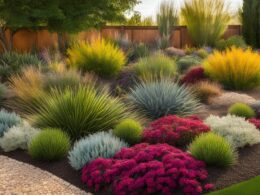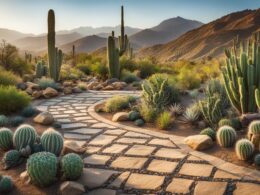Mulching is an essential practice in xeriscaping, a landscaping approach that promotes water conservation and sustainability. Mulch helps suppress weeds, reduce evapotranspiration, control erosion, improve drainage, and enhance the aesthetics of your xeriscaped landscape. There are two main types of mulch: organic (such as wood chips, bark, straw, and grass clippings) and inorganic (such as rocks and plastics). Choosing the right mulch for your garden depends on various factors, including plant preferences and desired aesthetic. Weed barriers, like plastic or landscape cloth, are generally discouraged in xeriscaping as they can create more problems than they solve.
Key Takeaways:
- Organic and inorganic mulch are the two main types used in xeriscaping.
- Organic mulch adds nutrients to the soil and improves soil structure, while inorganic mulch offers long-lasting coverage and a more formal aesthetic.
- Wood mulch provides excellent weed suppression and enhances soil moisture retention, while rock mulch offers superior weed control but can increase soil temperature.
- Avoid common mulching mistakes such as using weed barriers and applying too much mulch.
- Consider factors like plant preferences, maintenance requirements, and desired visual appeal when choosing mulch for your xeriscaped garden.
Understanding the Benefits of Mulching in Xeriscaping
Mulching offers several benefits in xeriscaping. It helps suppress weeds by creating a barrier that prevents weed growth. Mulch also reduces evapotranspiration, allowing more water to reach the plants instead of evaporating from the soil surface. It regulates soil temperature, keeping it cooler in summer and warmer in winter, which promotes healthier plant roots. Additionally, mulch controls erosion and improves water drainage. From an aesthetic perspective, mulch adds texture to the landscape and enhances visual appeal. Organic mulch, in particular, helps build organic content in the soil, improving soil structure and moisture retention.
By creating a barrier against weed growth, mulch significantly reduces the effort required for weed control in xeriscaped gardens. This allows you to spend less time pulling weeds and more time enjoying your beautiful landscape. Mulching also plays a crucial role in water conservation. By reducing evapotranspiration, mulch helps to maximize the water available to your plants, ensuring they receive the hydration they need to thrive. Additionally, mulch helps regulate soil temperature, protecting plant roots from extreme heat and cold, and promoting optimal growth and development.
In terms of aesthetics, mulch adds visual interest to your xeriscaped garden. Whether you choose organic or inorganic mulch, both options can enhance the overall appearance of your landscape by adding texture and definition. Organic mulch, such as wood chips or bark, can create a natural, rustic feel, while rocks or gravel can lend a more contemporary look to your garden. Whichever type of mulch you choose, it’s important to note that it also helps to improve soil health over time. Organic mulch breaks down and adds valuable nutrients to the soil, improving its structure and moisture-retaining capacity.
| Benefits of Mulching in Xeriscaping |
|---|
| Suppresses weeds |
| Reduces evapotranspiration |
| Regulates soil temperature |
| Controls erosion |
| Improves water drainage |
| Enhances visual appeal |
| Builds organic content in the soil |
With the understanding of the benefits of mulching in xeriscaping, you can make informed decisions about incorporating mulch into your landscape. Whether you prioritize weed suppression, water conservation, or aesthetic appeal, mulching offers a range of advantages that can help you achieve your desired results. Consider the specific needs of your plants and the overall design of your garden to choose the right type of mulch. With proper mulching techniques, you can create a thriving, low-maintenance xeriscaped garden that conserves water, supports plant health, and adds beauty to your outdoor space.
Organic vs. Inorganic Mulch: Which is Best for Xeriscaping?
When it comes to choosing the right mulch for your xeriscaped garden, you have the option of selecting between organic and inorganic mulch. Organic mulch, such as wood chips, bark, straw, and grass clippings, decomposes over time and adds valuable nutrients to the soil. It improves soil structure, retains moisture, and supports beneficial soil microbes. On the other hand, inorganic mulch, like rocks or plastics, does not decompose but offers long-lasting coverage and a more formal aesthetic.
The choice between organic and inorganic mulch depends on various factors, including personal preferences, plant requirements, and desired landscape appearance. Organic mulch is a great option if you prioritize soil health and want to enrich your garden naturally. It’s also beneficial for areas with plants that prefer a more acidic soil pH. In contrast, inorganic mulch is ideal for those seeking a low-maintenance solution with a consistent appearance. It works well in high-traffic areas and can withstand extreme weather conditions.
If you’re unsure which type of mulch to choose, it’s recommended to experiment with both organic and inorganic options and observe how they perform in your specific garden. You can even combine them in different areas to enjoy the benefits of each. For example, use organic mulch around plants where soil improvement is a priority and opt for inorganic mulch in areas where low maintenance and durability are key.
| Organic Mulch | Inorganic Mulch | |
|---|---|---|
| Decomposition | Decomposes over time and enriches the soil | Does not decompose |
| Aesthetics | Natural appearance, blends well with the landscape | Consistent appearance, formal and polished |
| Maintenance | May require periodic replenishment | Low maintenance, long-lasting |
| Weed Suppression | Provides good weed control | Excellent weed control |
| Moisture Retention | Retains moisture in the soil | Does not retain moisture |
Ultimately, the choice between organic and inorganic mulch for xeriscaping depends on your specific needs and preferences. Consider factors such as desired maintenance level, aesthetic preferences, plant requirements, and the overall goals of your xeriscaped garden. By carefully selecting the right mulch, you can create a beautiful, sustainable landscape that thrives with minimal water usage.
Mulch Options for Xeriscaping: Pros and Cons
When it comes to mulching in xeriscaping, you have several options to choose from, each with its own set of pros and cons. The two most common types of mulch used in xeriscaping are wood mulch and rock mulch. Let’s take a closer look at the advantages and disadvantages of each:
Wood Mulch
Wood mulch, such as wood chips or bark, is a popular choice for xeriscaping due to its organic nature and ability to decompose over time, adding organic matter to the soil. Here are some key points to consider:
- Pros: Wood mulch is excellent for weed suppression, as it forms a thick barrier that inhibits weed growth. It also helps retain soil moisture, preventing water evaporation and reducing the need for frequent irrigation. Additionally, wood mulch enriches the soil as it breaks down, improving its overall health and fertility.
- Cons: One potential drawback of wood mulch is that it may attract pests, such as termites or ants. However, this can be mitigated by choosing high-quality mulch from reputable sources. Wood mulch also requires occasional replenishment as it breaks down, so you’ll need to monitor and add mulch as needed.
Rock Mulch
Rock mulch, also known as gravel or pebble mulch, offers a different set of characteristics compared to wood mulch. Here’s what you need to know:
- Pros: Rock mulch is long-lasting and requires minimal maintenance, making it a low-maintenance option for xeriscaping. It provides excellent weed control by preventing weed germination and growth. Additionally, rock mulch offers a decorative aesthetic, adding texture and visual interest to your xeriscaped landscape.
- Cons: One potential downside of rock mulch is its ability to absorb and radiate heat. This can lead to increased soil temperature, potentially affecting the health of your plants, especially in hot climates. To mitigate this, consider using light-colored rocks that reflect sunlight or pairing rock mulch with shade-providing plants.
| Mulch Option | Pros | Cons |
|---|---|---|
| Wood Mulch | Excellent weed suppression Retains soil moisture Enriches soil health |
Potential attraction to pests Requires occasional replenishment |
| Rock Mulch | Low maintenance Effective weed control Decorative aesthetic |
Potential heat absorption Can raise soil temperature |
Ultimately, the best mulch option for your xeriscaped garden depends on your specific needs, preferences, and local climate. Consider the pros and cons of each mulch type and choose accordingly to create a beautiful and sustainable xeriscaped landscape that suits your vision.
Avoiding Common Mulching Mistakes in Xeriscaping
When mulching in your xeriscaped garden, it’s important to be aware of common mistakes that can hinder the effectiveness of your mulch and impact the overall health of your plants. By avoiding these mistakes, you can ensure that your mulching efforts contribute to the success of your xeriscaping project.
1. Using Weed Barriers Below Mulch
A common mistake is using weed barriers, such as plastic or landscape cloth, beneath the mulch layer. While it may seem like a good idea to prevent weed growth, these barriers can actually do more harm than good in xeriscaping. Weed barriers can hinder plant root growth, trap moisture, and prevent air circulation. Additionally, they can create an environment for weed germination on top of the barrier. It’s best to let the mulch directly contact the soil for optimal decomposition and soil health.
2. Applying Too Much Mulch
Another common mistake is applying too much mulch. While mulch is beneficial for weed suppression and moisture retention, an excessive layer can suffocate plant roots and hinder water penetration to the soil. It’s recommended to apply a 3-inch layer of mulch, ensuring that it is evenly distributed and not piled up against the base of plants. By maintaining the right amount of mulch, you can provide the necessary benefits without compromising plant health.
3. Neglecting Regular Maintenance
One mistake that is often overlooked is neglecting regular maintenance of the mulched areas. Mulch can break down over time, especially organic mulch, and may require occasional replenishment. It’s important to monitor the depth and condition of the mulch and add more as needed. Regularly check for pests, diseases, or weed growth in the mulched areas and address any issues promptly to maintain a healthy xeriscaped garden. By staying on top of maintenance tasks, you can ensure the long-term success of your mulching efforts.
“By avoiding common mulching mistakes in xeriscaping, you can maximize the benefits of mulch for weed suppression, moisture retention, and overall plant health.”
| Mulching Mistake | Impact | Solution |
|---|---|---|
| Using weed barriers | Hinders plant root growth and traps moisture | Let the mulch directly contact the soil |
| Applying too much mulch | Suffocates plant roots and hinders water penetration | Apply a 3-inch layer of mulch evenly |
| Neglecting regular maintenance | Mulch breaks down over time and may require replenishment | Monitor mulch depth and condition, add more as needed |
Key Considerations for Mulching in Xeriscaping
When it comes to mulching in xeriscaping, there are several key considerations you should keep in mind. These considerations will help ensure that you choose the right mulch, apply it correctly, and maintain a healthy and thriving xeriscaped garden.
1. Mulch selection:
Choose a mulch that is suitable for your specific plants and desired landscape design. Consider factors such as plant preferences, aesthetic appeal, and maintenance requirements. Organic mulches, like wood chips or bark, decompose over time and enrich the soil with nutrients. Inorganic mulches, such as rocks or plastics, offer long-lasting coverage and a more formal appearance. Experiment with different types of mulch to find the one that works best for your xeriscaped garden.
2. Proper application:
When applying mulch, be mindful of how close it is to plant stems or trunks. Leaving a small gap between the mulch and the base of plants helps prevent moisture buildup and potential rot or pest infestation. Aim for a 3-inch layer of mulch, ensuring that it covers the soil evenly without suffocating plant roots or hindering water penetration. This thickness provides effective weed suppression while maintaining optimal soil conditions.
3. Regular maintenance:
Mulched areas should be monitored regularly for signs of pests, disease, or weed growth. Promptly address any issues that arise to prevent them from spreading and causing damage to your xeriscaping efforts. Additionally, consider replenishing organic mulch periodically to maintain weed suppression and enhance soil enrichment. This maintenance ensures that your mulched areas remain healthy and supportive of your xeriscaped garden.
By considering these key factors, you can make informed decisions about mulching in xeriscaping. Remember to select the right mulch, apply it properly, and maintain it regularly to create a thriving and sustainable xeriscaped garden.
| Mulching Considerations | Key Points |
|---|---|
| Mulch Selection | – Choose mulch based on plant preferences and desired aesthetic. – Organic mulch adds nutrients and improves soil structure. – Inorganic mulch offers long-lasting coverage and a formal appearance. |
| Proper Application | – Leave a small gap between mulch and plant stems to prevent moisture buildup. – Apply a 3-inch layer of mulch for optimal weed suppression and soil conditions. |
| Regular Maintenance | – Monitor mulched areas for pests, disease, and weed growth. – Replenish organic mulch periodically to maintain weed suppression and soil enrichment. |
Planning a Successful Xeriscaped Garden with Mulching
When embarking on the journey of creating a xeriscaped garden with mulching, careful planning is essential to ensure success. By considering the specific needs of your plants, the local climate, and your desired aesthetic, you can create a flourishing garden that thrives with minimal water usage.
Start by selecting low-water-use plants that are native or well-adapted to your region’s climatic conditions. Grouping plants with similar water requirements together allows for efficient irrigation and mulching. Additionally, take into account the sun exposure in your yard and choose plants accordingly to optimize their growth.
Before mulching, evaluate your soil type and make any necessary amendments to enhance its quality. Consider using organic mulch, such as wood chips or bark, which decomposes over time and enriches the soil with nutrients. This type of mulch also helps with weed suppression and moisture retention.
Lastly, plan for an efficient irrigation system, such as drip irrigation or soaker hoses, to deliver water directly to the roots of your plants and minimize water waste. By implementing these considerations when planning your xeriscaped garden with mulching, you can create a beautiful and successful landscape that conserves water and supports sustainable gardening practices.
Table: Mulching Considerations
| Consideration | Description |
|---|---|
| Plant Selection | Choose low-water-use plants that are native or well-adapted to your region’s climate. |
| Grouping Plants | Group plants with similar water requirements together for efficient irrigation and mulching. |
| Soil Evaluation | Evaluate your soil type and make necessary amendments to enhance its quality. |
| Organic Mulch | Consider using organic mulch, such as wood chips or bark, for nutrient enrichment and weed suppression. |
| Irrigation System | Plan for an efficient irrigation system, such as drip irrigation or soaker hoses, to minimize water waste. |
Conclusion
Mulching is an essential practice in xeriscaping that offers numerous benefits for your garden. By choosing the right mulch and understanding its advantages, you can create a sustainable and visually appealing landscape while conserving water.
Organic mulch, such as wood chips, bark, straw, and grass clippings, improves soil structure, retains moisture, and supports beneficial soil microbes. Inorganic mulch, like rocks or plastics, provides long-lasting coverage and a formal aesthetic. Experimenting with both types can help you determine what works best for your garden.
Avoid common mulching mistakes, such as using weed barriers or applying too much mulch. These can hinder plant growth and soil health. Instead, let the mulch directly contact the soil and maintain a 3-inch layer for optimal weed suppression and moisture retention.
By considering factors like plant preferences, maintenance requirements, and aesthetic goals, you can plan a successful xeriscaped garden with mulching. Choose low-water-use plants, group them based on water requirements, and implement efficient irrigation systems. With the right mulching methods, you can create a beautiful and environmentally friendly landscape that thrives with minimal water usage.













